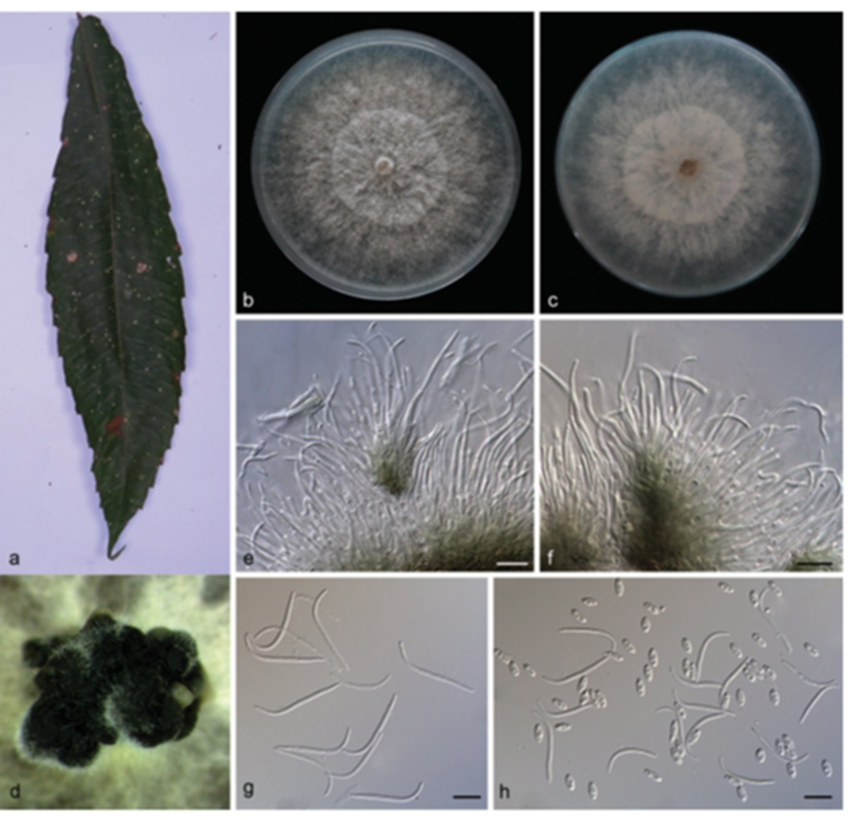 89
89
Diaporthe pometiae S.T. Huang, J.W. Xia, W.X. Sun, & X.G. Zhang, sp. nov.2021
Type:China, Yunnan Province: Xishuangbanna Tropical Botanical Garden, Chi nese Academy of Sciences, on diseased leaves of Pometia pinnata (Sapindaceae). 19 April 2019, S.T. Huang, HSAUP194.72 holotype, ex-type living culture SAUCC194.72.
Description:
Asexual morph: Leaf spots subcircular, fawn to dark brown. Con idiomata pycnidial, subglobose to globose, aggregated in groups, black, coated with white hyphae, thick-walled, exuding creamy droplets from ostioles. Conidiophores hyaline, smooth, slightly septate, branched, densely aggregated, cylindric-clavate, straight to slightly sinuous, 22.5–32.5 × 1.0–2.0 μm. Conidiogenous cells 15.0–22.5 × 1.0–1.5 μm, phialidic, cylindrical, multi-guttulate, terminal, tapering towards apex. Alpha conidia abundant in culture, 2–4 guttulate, hyaline, smooth, aseptate, ellipsoi dal to oblong ellipsoidal, with both ends obtuse, 5.7–8.3 × 2.2–3.0 μm (mean = 6.7 × 3.1 μm, n = 20). Beta conidia, hyaline, aseptate, filiform, multi-guttulate, slightly curved, tapering towards to apex, 27.8–34.5 × 1.0–1.7 μm (mean = 21.7 × 1.4 μm, n = 20). Gamma conidia not observed.
Sexual morph: Undetermined
Culture characteristics: Cultures incubated on PDA at 25 °C in darkness, growth rate 11.5–13.0 mm diam/day, cottony with abundant aerial mycelium, with a concen tric zonation, white on surface, white to grayish on reverse.
Habitat: Undetermined:
Distribution:China
GenBank Accession: ITS MT822547,TUB MT855744,TEF MT855861,CAL MT855632,HIS MT855516;ITS MT822600,TUB MT855797,TEF MT855912,CAL MT855679,HIS MT855568;
ITS MT822601,TUB MT855798,TEF MT855913,CAL MT855680,HIS MT855569;
Notes: Diaporthe pometiae is introduced based on the multi-locus phylogenetic analysis, with three isolates clustering separately in a well-supported clade (ML/BI = 100/1). Diaporthe pometiae is most closely related to D. biconispora, but distinguished based on ITS, TUB, TEF and HIS loci by 74 nucleotide differences in the concatenat ed alignment, in which 2/492 are distinct in the ITS region, 8/353 in the TUB region, 49/370 in the TEF region and 15/471 in the HIS region. Morphologically, Diaporthe pometiae differs from D. biconispora in its smaller alpha conidia (5.7–8.3 × 2.2–3.0 vs. 6.0–10.5 × 2–3.5 μm). Furthermore, Diaporthe pometiae produces beta conidia unlike D. biconispora (Huang et al. 2015).
Referenc: [1] Huang, S. , Xia, J. , Zhang, X. , & Sun, W. X. . (2021). Morphological and phylogenetic analyses reveal three new species of diaporthe from yunnan, china. MycoKeys, 78, 49-77.

a infected leaf of Pometia pinnata b, c surface and reverse of colony after 15 days on PDA d conidiomata e, f conidiophores and conidiogenous cells g beta conidia h alpha conidia and beta conidia. Scale bars: 10 μm (e–h).

